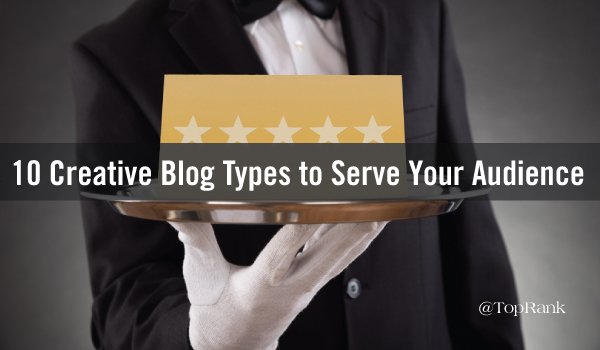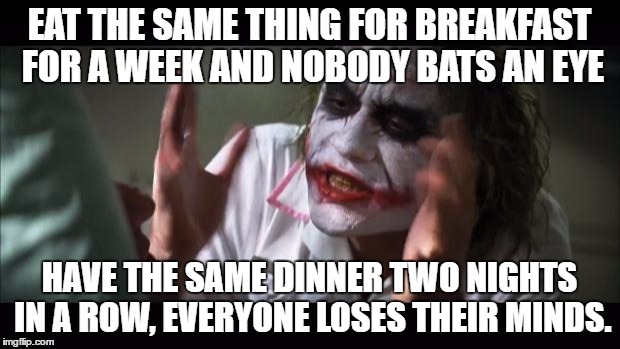When it comes to blog content, a lot of us are serving breakfast when we should be serving dinner.
Let me explain. Odds are you have a go-to breakfast that you eat nearly every day. A bowl of cereal with a banana, some oatmeal with maple syrup, a haunch of beef seasoned with the tears of your enemies-generally there's not much variety from day to day. On the other hand…
For dinner, we generally require some variety. Maybe it's that no one is fully awake for breakfast, so it doesn't matter what you eat. Maybe it's the realization that eggs and bacon are perfect foods.
Either way, people come to your website expecting dinner. If you keep hitting them with oatmeal and toast, they're not likely to keep coming back. Serve up a delicious variety of entrees, though, and you can start to build a relationship.
Here are a few different types of blog posts to help keep your content fresh.
#1: List Posts
Studies have found that list posts (or “listicles” if you absolutely must), especially those with numbers in the title, tend to be shared more often than any other type of content.
That makes sense. List posts are already optimized for web reading. They're skimmable; they have small sections broken up by headers; it's easy to tell where you are in the piece and how much you have left to go.
In fact, it's easy to share a list post without even reading it all. If the headline and the first entry are compelling, people will click the share button.
#2: How-To Posts
Posts that explain a process hit several boxes on the “great content” checklist. As long as they're relevant to your audience, they're designed to have immediate practical value. They also establish your brand as an authority. And they can be an evergreen resource customers can keep coming back to.
When writing a how-to post, think about your audience beyond just their interaction with your brand. What do they really need to know, versus what you want to tell them?
My favorite example of how-to posts done right comes from hardware store Lowe's. They have hundreds of guides, like this one about installing a fence.
If your topic is inherently visual, how-to videos can be cheap and easy to produce. This video about making stress balls is compelling with almost zero production value.
#3: Tips Posts
Think of a tips post as something in-between a list and a how-to. Instead of explaining a single process start-to-finish, you're providing little nuggets of tactical goodness with each entry. They're highly skimmable like list posts and evergreen like how-tos.
As with a list post, you could go for 50 quick one-sentence entries or go in-depth on just a few. This article on increasing Facebook organic reach is a good example of the latter.
A list of quick, useful tips can take on a life of its own through re-sharing and repurposing. For example, you can pull a few tips from the list and turn them into social media images with Canva or Pixlr. Or turn the whole post into a SlideShare and reach a new audience.
The word “tips” tends to have long-tail keyword value, too. For example, “content marketing” is a more highly-competitive keyword than “content marketing tips,” and “content marketing tips” is a more specific topic that is easier to write best answer content for.
#4: Tools Posts
If your company deals with software or online activity of any kind, odds are you can whip up a relevant tools post that will delight your readers. Wrap up all the free or low-cost useful sites, plugins, and downloads that make your life easier and share them with your readers.
There's an immense amount of sharing potential in tool posts. My recent content marketing tools post is one of my highest-shared posts already, and it's only been out a month. Heck, RazorSocial's Ian Cleary built a career on evaluating and recommending tools for social media.
Just make sure to keep it useful, keep it relevant, and disclose any relationship your company has with the tools you're promoting. For example, if you get a free LinkedIn Premium account through work, and you recommend customers sign up for the service, you must disclose.
#5: Thought Leadership Posts
These posts help position your company as a knowledgeable authority in your industry-and most importantly, as having a point of view on the issues that affect your potential customers. Thought leadership posts come in three types:
- Industry: Demonstrating a point of view on the news and trends affecting your industry now nad in the future
- Product: Practical advice for getting the most utility out of your product offering
- Organizational: A look into your company culture, your company philosophy, what it's like to work there
Thought leadership helps make your brand transparent, showcasing the people and ideas that make your company great.
#6: Round-ups
One easy way to fill your editorial calendar is with a weekly roundup (like our Online Marketing News series). You can build a list of go-to resources that regularly publish articles about your industry, and feature a few articles with brief summaries.
Or use a tool like Buzzsumo to round up the most shared or trending articles about your industry. Either way, you can provide the reader with a useful resource and boost your brand's credibility.
Don't forget to message the authors when you include them in a roundup for amplification potential, too.
#7: Curated Influencer Posts
Influencer involvement is great for enhancing a post's credibility and building relationships. For your audience, influencer involvement adds variety in the point of view on your blog, multiplying the utility of your content.
A curated influencer post is one that collects influencer quotes from publicly available sources, rather than through direct outreach. For example, this “What Is Content Marketing?” post from (our client) LinkedIn Marketing Solutions collects 25 already-existent quotes from some of the biggest names in content marketing. It remains one of the blog's most popular posts, and it only took a little research to put it together.
Curated posts are a good way to start a relationship with an influencer as well. Let them know you're sharing their wisdom with the world, give them proper credit, and you're set up to ask for a direct participation post.
#8: Influencer Participation Posts
Influencer marketing can create content that benefits everyone involved: Your brand and the influencer get access to new audiences and boosted credibility, and readers get cool co-created content to read.
A post with genuine influencer participation could be a simple Q&A with one influencer, or short responses to a prompt from several influencers.
#9: “Chocolate Cake” Post
As adults, we know that desserts are not a main course, and (as cookie monster tells us), are a “sometimes food.” You wouldn't want to give your audience cavities with chocolate cake every day, but every once in a while a light, sweet diversion is just what they need.
Think April Fool's Day posts, collections of funny memes, even a Buzzfeed-style GIF-driven post. It should always have a little bit of value beyond the humor, but the focus is on having fun. Jason Miller's annual interviews with Dracula are a great example of the form.
#10: Interactive Content
It's all well and good to have your audience passively reading your content, but even better when they can interact with it in a meaningful way.
If you have the resources, developing a calculator or other useful widget (like CoSchedule's Headline Analyzer) is sure to get your audience's attention.
Even without an army of developers, though, you can create an engaging bit of interactive content. Make a quiz with a tool like QZZR, a survey with Survey Monkey, or an interactive, clickable word cloud with Wordle.
Serve up a Never-Ending Content Buffet
These ten examples are just a few of the hundreds of content types available. And you can make your own by mixing-and-matching-how about a list post featuring a round-up of how-to posts? Or a tools post created by asking influencers to name their favorite tools? With a little creativity, the possibilities are endless.
What's your favorite creative type of blog post? Let me know in the comments.
Gain a competitive advantage by subscribing to the
TopRank® Online Marketing Newsletter.
© Online Marketing Blog - TopRank®, 2016. |
Avoid Content Ennui: 10 Creative Blog Types to Serve Your Audience | http://www.toprankblog.com
The post Avoid Content Ennui: 10 Creative Blog Types to Serve Your Audience appeared first on Online Marketing Blog - TopRank®.


No comments:
Post a Comment